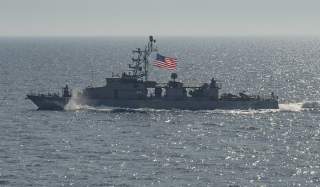The Navy’s Smallest Warships Could Be the First to See Combat Against Iran
Check them out.
If the United States and Iran go to war in the Persian Gulf, the U.S. Navy’s smallest warships could be the first to see combat.
The Navy’s 13 Cyclone-class patrol boats -- also known as “PCs” for “patrol, coastal” -- each displace just 330 tons of water. An Arleigh Burke-class destroyer, by contrast, displaces more than 9,000 tons of water. A standard crew aboard a Cyclone includes just 28 officers and sailors.
Ten Cyclones, operating from a base in Bahrain, comprise America’s naval vanguard in the Persian Gulf. They are the only U.S. warships that permanently operate off the Iranian coast. Other, larger vessels periodically deploy to the region.
The Cyclones are not widely known. Even the Navy in the past has failed to appreciate the 180-foot-long vessels, despite the extreme danger they could encounter during wartime. Congress in 2015 struck the Cyclones from the official tally of around 280 “battle force ships” that the Navy expects to play a major role in a large-scale conflict.
Each packing two 25-millimeter cannons plus machine guns, grenade-launchers and two quadruple mounts for short-range Griffin anti-ship missiles, the Cyclones arguably are the most heavily-armed American warships relative to their size.
Since acquiring the patrol boats in the mid-1990s until recently, the Navy struggled to find a place for the diminutive vessels in a fleet dominated by much larger, ocean-going aircraft carriers, cruisers and destroyers. The patrol boats lack the range and seakeeping to deploy on their own, so the fleet must hire heavy-lift vessels to haul the tiny warships across oceans.
The Cyclones spent a decade in a kind of planning limbo. But then in 2003, the United States invaded Iraq. The patrol boats suddenly found their calling.
The waters of the Persian Gulf around Iraq’s sole oil terminal, where tanker ships hook up to load the precious crude, are too shallow for destroyers and cruisers. So to protect the strategic oil facility, the Navy deployed Cyclones.
The tiny but hard-hitting boats proved adept at shallow-water patrols. After the reborn Iraqi navy took over oil-terminal protection in the mid-2000s, the Cyclones shifted to more general missions in the waters separating Iraq and Iran.
“They are fulfilling long-standing and validated naval missions, functions and tasks, protecting U.S. national interests while providing stabilizing assurance to our allies and partners in a volatile region of the world,” the Navy said of the Cyclones.
To better prepare the patrol boats for combat in crowded, chaotic waters, in 2013 the Navy began improving the vessels — adding the Griffin missiles to greatly boost the boats’ firepower.
The Cyclones perhaps could outfight many of the gun- and rocket-armed boats and corvettes that make up the bulk of the Iranian navy and the naval militia of the Iranian Revolutionary Guard Corps. But any patrol boat lacking serious air-defense systems is vulnerable to shore- and air-launched heavy anti-ship missiles.
The Navy plans to keep the Cyclones in service beyond the current five-year planning period that ends in 2024. After that, the fleet should consider replacing the patrol boats with “PC(R)” robotic vessels, Navy lieutenant commander Collin Fox argued in the February 2019 issue of Proceedings, the professional journal of the U.S. Naval Institute.
"Medium-displacement unmanned surface vessels are coming to the fleet; but when, how, and what roles they will fill are open questions," Fox writes. "Rather than developing a new MDUSV from scratch, the Navy should take advantage of the requirement to replace the Cyclone-class patrol coastal ships to develop a capable, mature MDUSV—killing two birds with one stone."
The new robotic patrol boat could borrow the hull of the Coast Guard’s 350-ton-displacement Sentinel-class cutter, Fox pointed out. The Coast Guard also refers to the Sentinels by their class code “WPC.”
“The Navy should latch onto the Coast Guard’s WPC program to acquire a PC(R) that could also serve as a MDUSV development platform and, eventually, a MDUSV,” Fox wrote. “A vessel based on the WPC would take advantage of the Coast Guard’s sunk development costs and production learning curve, while also leveraging multiyear procurement to achieve still greater cost savings.
A robotic patrol boat, in theory, could perform the same dangerous mission that the Cyclones do, but without risking American lives.
David Axe serves as Defense Editor of the National Interest. He is the author of the graphic novels War Fix, War Is Boring and Machete Squad.

